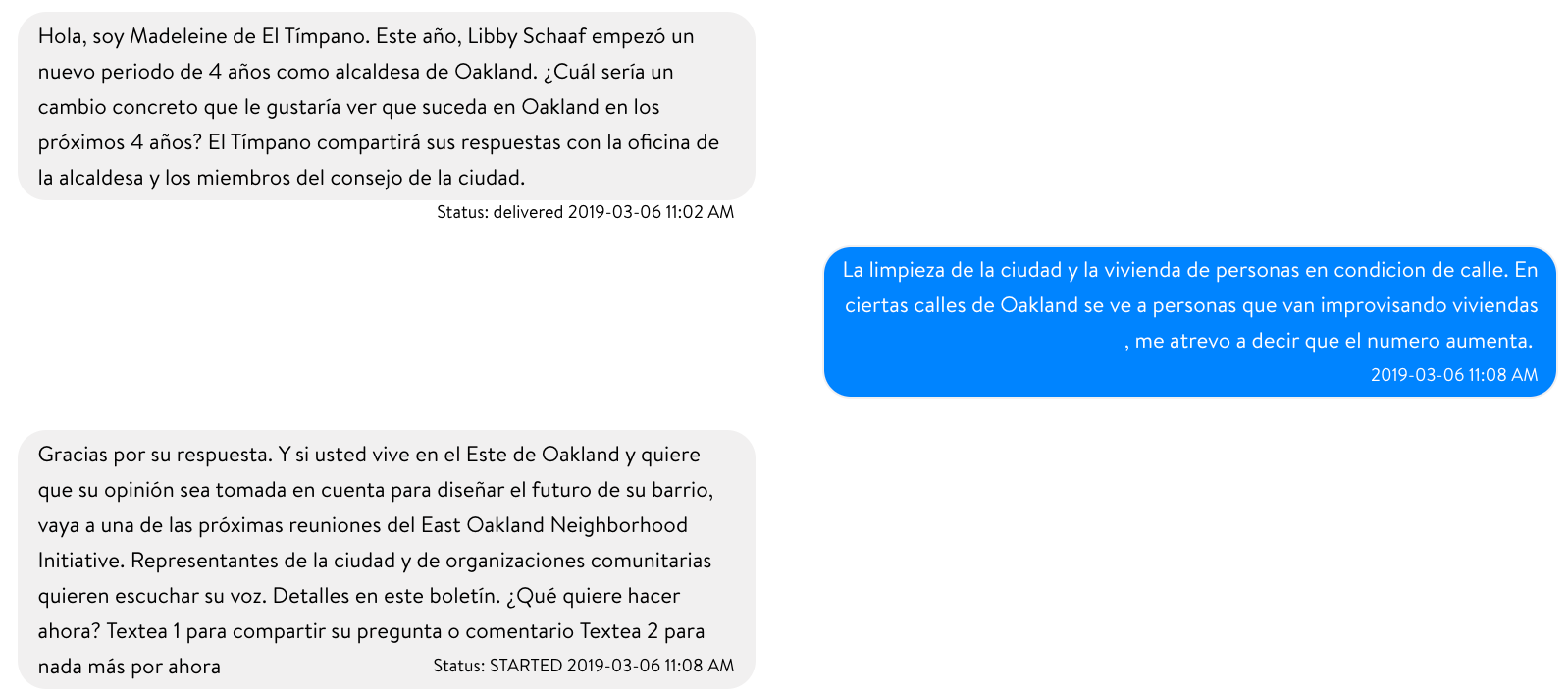
Why El Tímpano launched a text-message reporting pilot
The fact that East Oakland, California, is a media desert, particularly for immigrant residents, is clear. In the past two decades, the Latino immigrant community has grown faster than any other in the city. At the same time, options for Spanish-language news have diminished. For many of the Bay Area’s Latino immigrants, the daily half-hour news broadcasts from Univision and Telemundo, covering the entire 9-county region, are the extent of “local” news.
Figuring out how to fill that gap, though, is far from clear. Yet that’s exactly what El Tímpano set out to do.
Our latest pilot, called “Pasa La Voz” (Spanish for “Spread the Word”) demonstrates one model of what that could look like. The 3-month pilot developed out of the feedback and ideas of hundreds of residents we talked to, who told us what they want to see in local media (and more than that, what they don’t), what issues matter to them, and how to deliver the information they need.
Pasa La Voz was designed to be a participatory local news service providing empowering, local information to Oakland’s Latino immigrant community through text messages. Each week, subscribers received news, resources, or information on issues such as health, housing, education, emergency preparedness, and immigration, and also had the opportunity to share their questions, concerns, or stories on that issue.
Yes, text messages
When we asked residents in surveys and workshops where they get news and information, websites ranked low on the list. So did email and Twitter. It was clear that a news outlet designed for Latino immigrants would look different from your average news startup. Some residents suggested that Oakland should have a Spanish-language Facebook news page, though others expressed unease about misinformation and rumors that circulate on the platform. (For more on what we learned from our participatory research process, check out El Tímpano’s Information Needs Assessment.)
“Que manden noticias por texto para que se puede conseguir mientras que estás en el trabajo” (“Send news through text so you can get it while you’re at work”), one resident suggested. Text message distribution also came up in conversation with community organizers and educators, who often use mass texts or phone trees to get important information to community members. While not everyone has a home computer or email address, nearly everyone has a cell phone. Text messages it was.
Due to more than a year’s worth of groundwork we had conducted as well as an earlier pilot, we already had a list of some 360 phone numbers of residents eager to participate, as well as relationships with other local organizations with whom we could partner with to spread the word.
Actionable news and two-way communication
With the platform determined, what issues would we cover, and how would we present the news?
In workshops and surveys, we heard again and again that residents felt disempowered by the news they were getting. One community leader captured this widespread sentiment when he told us, “I want news that helps me take action rather than leaving me feeling defeated and helpless.”
What residents DO want, they told us, is “más información que la gente puede usar” (“more information people can use”). That is, if the issue of the day is about housing displacement, don’t just tell me how many people have been evicted from my community. Tell me what to do when I get an eviction notice, or how I can voice my opinion to local officials.
Inspired by Listening Post NOLA, we decided to focus on one issue each week, and provide actionable information while also inviting our audience to share their questions, stories, or concerns on the topic at hand.
For example, one message provided information about the recent citywide minimum wage increase, along with the number of a legal aid organization, and a prompt to respond if you had ever been underpaid at work.
Another week we shared information about the mayor’s new four-year term and a community forum where residents were invited to design their vision for East Oakland’s future. We asked residents what change they wanted to see in Oakland, and received 28 concrete responses, from fixing potholes to building affordable housing and addressing crime, illegal dumping, and homelessness. We passed them along to the offices of the mayor and city council members.

When Pasa La Voz featured the rapid bus system under construction, we collected questions in advance of a community meeting on the issue, where we posed them directly to officials.
Metrics and next steps
From the responses El Tímpano received from our audience, as well as data on subscriber engagement and growth, we see Pasa La Voz as a successful model of local, empowering reporting.
Here’s what we know:
- By the end of the pilot, 399 people had signed up to receive Pasa La Voz.
- About
13% of subscribers responded to the messages at least once, and half of
that responded more than once. There were more than a dozen
super-participants, who responded to several of the messages.
With the majority of our audience not responding at all, we had to wonder how many read the messages, and how many simply never got around to unsubscribing. We’d like to think that the individual who sent us this text at the end of the pilot wasn’t the only one who felt this way: “I hope you reconsider bringing this initiative to an end. It is a project with great potential and is very beneficial to the Latino community.” It was the first message that person had ever sent us.
Several audience members, in fact, expressed their eagerness to help to keep Pasa La Voz going, and more generally, to take part in the development of El Tímpano. With support from the Membership Puzzle Project, we will be forming a community advisory board to leverage this interest and continue designing local news in collaboration with residents. As for Pasa La Voz, we hope to secure the funds and partnerships we need to build El Tímpano’s infrastructure and expand upon this pilot initiative.
